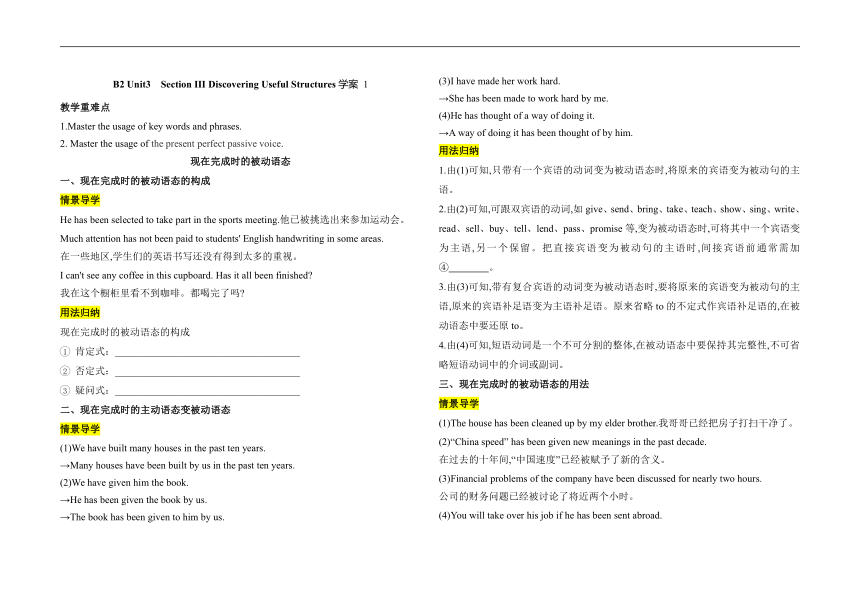人教版(2019)必修 第二册Unit 3 The internet Discovering Useful Structures 学案(无答案)
文档属性
| 名称 | 人教版(2019)必修 第二册Unit 3 The internet Discovering Useful Structures 学案(无答案) |  | |
| 格式 | docx | ||
| 文件大小 | 20.9KB | ||
| 资源类型 | 教案 | ||
| 版本资源 | 人教版(2019) | ||
| 科目 | 英语 | ||
| 更新时间 | 2024-04-04 09:51:40 | ||
图片预览

文档简介
B2 Unit3 Section Ⅲ Discovering Useful Structures学案 1
教学重难点
1.Master the usage of key words and phrases.
2. Master the usage of the present perfect passive voice.
现在完成时的被动语态
一、现在完成时的被动语态的构成
情景导学
He has been selected to take part in the sports meeting.他已被挑选出来参加运动会。
Much attention has not been paid to students' English handwriting in some areas.
在一些地区,学生们的英语书写还没有得到太多的重视。
I can't see any coffee in this cupboard. Has it all been finished
我在这个橱柜里看不到咖啡。都喝完了吗
用法归纳
现在完成时的被动语态的构成
肯定式:_____________________________________
否定式:_____________________________________
疑问式:_____________________________________
二、现在完成时的主动语态变被动语态
情景导学
(1)We have built many houses in the past ten years.
→Many houses have been built by us in the past ten years.
(2)We have given him the book.
→He has been given the book by us.
→The book has been given to him by us.
(3)I have made her work hard.
→She has been made to work hard by me.
(4)He has thought of a way of doing it.
→A way of doing it has been thought of by him.
用法归纳
1.由(1)可知,只带有一个宾语的动词变为被动语态时,将原来的宾语变为被动句的主语。
2.由(2)可知,可跟双宾语的动词,如give、send、bring、take、teach、show、sing、write、
read、sell、buy、tell、lend、pass、promise等,变为被动语态时,可将其中一个宾语变为主语,另一个保留。把直接宾语变为被动句的主语时,间接宾语前通常需加④ 。
3.由(3)可知,带有复合宾语的动词变为被动语态时,要将原来的宾语变为被动句的主语,原来的宾语补足语变为主语补足语。原来省略to的不定式作宾语补足语的,在被动语态中要还原to。
4.由(4)可知,短语动词是一个不可分割的整体,在被动语态中要保持其完整性,不可省略短语动词中的介词或副词。
三、现在完成时的被动语态的用法
情景导学
(1)The house has been cleaned up by my elder brother.我哥哥已经把房子打扫干净了。
(2)“China speed” has been given new meanings in the past decade.
在过去的十年间,“中国速度”已经被赋予了新的含义。
(3)Financial problems of the company have been discussed for nearly two hours.
公司的财务问题已经被讨论了将近两个小时。
(4)You will take over his job if he has been sent abroad.
如果他被派往国外,你将接手他的工作。
(5)We won't start the work until all the preparations have been made.
直到所有的准备工作都做好了,我们才开始工作。
用法归纳
1.例句(1)(2)表示被动的动作在说话之前已经⑤ ,强调过去的动作对现在造成的影响或产生的结果,常与时间状语just、already、yet、ever、recently、lately、so far、up to/till now、before、in the last/past few days等连用。
2.例句(3)表示一个被动的动作开始于过去,持续到⑥ ,并且有可能继续持续下去, 常与带for或since的时间状语连用,或用于“How long... ”句型中。
3.例句(4)(5)表示在⑦ 或条件等状语从句中,表示将来某时已完成的被动的动作,可以用现在完成时的被动语态代替将来完成时的被动语态。
即时巩固
Ⅰ.单句语法填空
1.(2020天津5月)—The machine is working again!
—Yes, it broke down yesterday, but it (fix).
2.How many suggestions (give)to you so far
3.Hundreds of excellent athletes (select)from all over the world in the past two months.
4.A new library and a gym in our school (set)up so far and they will be put into use very soon.
5.When and where to go for their holiday (decide)yet.
Ⅱ.把下面的句子变为被动语态
1. We have made him clean the room.
→He the room by us.
2.They have taken good care of the orphans here.
→The orphans by them here.
3.The company has given him a chance to work abroad recently.
→He a chance to work abroad recently by the company.
→A chance to work abroad him recently by the company.
教学重难点
1.Master the usage of key words and phrases.
2. Master the usage of the present perfect passive voice.
现在完成时的被动语态
一、现在完成时的被动语态的构成
情景导学
He has been selected to take part in the sports meeting.他已被挑选出来参加运动会。
Much attention has not been paid to students' English handwriting in some areas.
在一些地区,学生们的英语书写还没有得到太多的重视。
I can't see any coffee in this cupboard. Has it all been finished
我在这个橱柜里看不到咖啡。都喝完了吗
用法归纳
现在完成时的被动语态的构成
肯定式:_____________________________________
否定式:_____________________________________
疑问式:_____________________________________
二、现在完成时的主动语态变被动语态
情景导学
(1)We have built many houses in the past ten years.
→Many houses have been built by us in the past ten years.
(2)We have given him the book.
→He has been given the book by us.
→The book has been given to him by us.
(3)I have made her work hard.
→She has been made to work hard by me.
(4)He has thought of a way of doing it.
→A way of doing it has been thought of by him.
用法归纳
1.由(1)可知,只带有一个宾语的动词变为被动语态时,将原来的宾语变为被动句的主语。
2.由(2)可知,可跟双宾语的动词,如give、send、bring、take、teach、show、sing、write、
read、sell、buy、tell、lend、pass、promise等,变为被动语态时,可将其中一个宾语变为主语,另一个保留。把直接宾语变为被动句的主语时,间接宾语前通常需加④ 。
3.由(3)可知,带有复合宾语的动词变为被动语态时,要将原来的宾语变为被动句的主语,原来的宾语补足语变为主语补足语。原来省略to的不定式作宾语补足语的,在被动语态中要还原to。
4.由(4)可知,短语动词是一个不可分割的整体,在被动语态中要保持其完整性,不可省略短语动词中的介词或副词。
三、现在完成时的被动语态的用法
情景导学
(1)The house has been cleaned up by my elder brother.我哥哥已经把房子打扫干净了。
(2)“China speed” has been given new meanings in the past decade.
在过去的十年间,“中国速度”已经被赋予了新的含义。
(3)Financial problems of the company have been discussed for nearly two hours.
公司的财务问题已经被讨论了将近两个小时。
(4)You will take over his job if he has been sent abroad.
如果他被派往国外,你将接手他的工作。
(5)We won't start the work until all the preparations have been made.
直到所有的准备工作都做好了,我们才开始工作。
用法归纳
1.例句(1)(2)表示被动的动作在说话之前已经⑤ ,强调过去的动作对现在造成的影响或产生的结果,常与时间状语just、already、yet、ever、recently、lately、so far、up to/till now、before、in the last/past few days等连用。
2.例句(3)表示一个被动的动作开始于过去,持续到⑥ ,并且有可能继续持续下去, 常与带for或since的时间状语连用,或用于“How long... ”句型中。
3.例句(4)(5)表示在⑦ 或条件等状语从句中,表示将来某时已完成的被动的动作,可以用现在完成时的被动语态代替将来完成时的被动语态。
即时巩固
Ⅰ.单句语法填空
1.(2020天津5月)—The machine is working again!
—Yes, it broke down yesterday, but it (fix).
2.How many suggestions (give)to you so far
3.Hundreds of excellent athletes (select)from all over the world in the past two months.
4.A new library and a gym in our school (set)up so far and they will be put into use very soon.
5.When and where to go for their holiday (decide)yet.
Ⅱ.把下面的句子变为被动语态
1. We have made him clean the room.
→He the room by us.
2.They have taken good care of the orphans here.
→The orphans by them here.
3.The company has given him a chance to work abroad recently.
→He a chance to work abroad recently by the company.
→A chance to work abroad him recently by the company.
